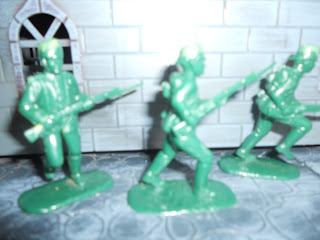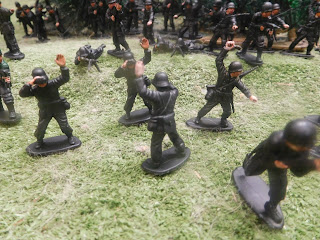Collecting in the 1980s or Quantrill Changes Sides
The 1980s was the time when my collecting and toy soldier links vastly expanded. I had been teaching at rural Victorian towns. When I began teaching at Sale I temporarily shared a house in a nearby town of Maffra. As mentioned elsewhere, this led to me being put into contact with wargamer, collector and budding sculptor, Paul Clarke. This was twenty five years ago. I had read an ad in Military Modelling magazine for Plastic Warrior but had assumed that this was an English affair and of limited use to me. From Paul I learnt that ACOTS (Australian Collectors of Toy Soldiers), which was loosely affiliated to the founding of Plastic Warrior magazine, was going to meet at a house in Caulfield, Melbourne.
Paul also got me involved with American Civil War re-enactment with the Bucknells. A lady in Sale made me a full Confederate cavalry officer's uniform, complete with a red shirt based on Jesse James' guerrilla shirt with blue trim around spacious pockets designed to carry ammunition, shell jacket with yellow cuffs and collar, gold 'chicken guts' or Austrian braid and authentic trousers, all a bit conspicuous with an infantry re-enactment unit. The Confederate uniforms were better looking than the Federal ones, the re-enactment group was Confederate and I had become fascinated with the history of the Ohio teacher, William Quantrill, who had decided to fight as a partisan for the Confederacy. (More on that in a future post). I wore this uniform whenever ACOTS had an ACW wargame, which was common for most of our conventions. Unfortunately the shell jacket is too small on me now. But almost invariably I have been on the Confederate side.
Our first ACOTS meeting involved a handful of toy soldier collectors at Alan Copsey's house. Yet among people attending were those from NSW and South Australia. When I say this it is not like in Britain someone coming from Cornwall or Wales to London. We are talking about twenty times those distances, more like someone coming to London from Russia or Turkey. People had driven all day to get there.
On arrival I had an old wooden hinged box filled with old toy soldiers. The first person I met, on arrival, was Brenton Hoffman of Adelaide who kindly offered to unload my stuff. Of course, he may have had on his mind obtaining some interesting swaps.
Having just gone through a 'model sodier' stage of my collecting I had higher regard for anatomically and historically correct figures than some of the cruder toy soldier types. In fact I always corrected people and said that they were model soldiers, not toy soldiers. For that reason I easily parted with some of my crude Speedwell African natives, which I had obtained from childhood friend, Peter. None of us then knew that the figures were Speedwell and variously they had been ascribed to Charbens or an unknown Spanish maker. Only recently has Plastic Warrior highlighted their origins. From Brenton I received some nice gold hard plastic Cafe Storm 18th century period French courtly figures. They would paint up nicely. Yet the native figures are now known as being among the rarest of plastic figures and I had forgotten, briefly, the childhood fascination that they had for me. (Recently I obtained a figure back from Brenton in a swap and I have five of the figures. Two of these are white explorers minus their native captors that they were cut away from. I am still hopeful that one day I shall obtain this vignette of captor and captive and also the hunter and snake in the grass which I have never had. But I digress.
I also brought about thirty assorted makes and periods I had painted. Whilst obtaining praise for my paintwork I also was told by Robert Bolton, of Adelaide that if I had painted all the same types I could have painted some nice regiments. With those fateful words I was launched on an epic journey of creating whole armies.
Bob (Robert) was into big armies, consisting of thousands of toy soldiers. He and Brenton had whole armies of ACW, and ancients, amongst others. I would see their setups when I visited Adelaide the next year. This convention we had our wargame on the underlay in one of Alan Copsey's rooms. Roads and rivers were carefully chalked on and an ACW game was fought in glorious 1/32 scale. Paul Clarke brought a major part of the figures with others having made the long march from Adelaide. Most of these figures were Herald, Britains Swoppets and Lone Star, all beautifully painted and converted by their owners and including flag bearer, officer and bugler or drummer boy for each regiment of twenty four infantry and regiments of twelve cavalry. The rules used had been evolved by the Adelaide crew and were loosely based on those of Featherstone but limited to one or two pages. There was no tedious, lengthy calculation of casualties resulting in a tick on a sheet rather than the removal of actual figures, as occurred with some 'serious' wargame rules for 20mm/25mm wargames. As I moved my units around the battlefield I was hooked, hooked badly.
Next blog will continue the ACOTS story and also other toy soldier contacts.
Paul also got me involved with American Civil War re-enactment with the Bucknells. A lady in Sale made me a full Confederate cavalry officer's uniform, complete with a red shirt based on Jesse James' guerrilla shirt with blue trim around spacious pockets designed to carry ammunition, shell jacket with yellow cuffs and collar, gold 'chicken guts' or Austrian braid and authentic trousers, all a bit conspicuous with an infantry re-enactment unit. The Confederate uniforms were better looking than the Federal ones, the re-enactment group was Confederate and I had become fascinated with the history of the Ohio teacher, William Quantrill, who had decided to fight as a partisan for the Confederacy. (More on that in a future post). I wore this uniform whenever ACOTS had an ACW wargame, which was common for most of our conventions. Unfortunately the shell jacket is too small on me now. But almost invariably I have been on the Confederate side.
Our first ACOTS meeting involved a handful of toy soldier collectors at Alan Copsey's house. Yet among people attending were those from NSW and South Australia. When I say this it is not like in Britain someone coming from Cornwall or Wales to London. We are talking about twenty times those distances, more like someone coming to London from Russia or Turkey. People had driven all day to get there.
On arrival I had an old wooden hinged box filled with old toy soldiers. The first person I met, on arrival, was Brenton Hoffman of Adelaide who kindly offered to unload my stuff. Of course, he may have had on his mind obtaining some interesting swaps.
Having just gone through a 'model sodier' stage of my collecting I had higher regard for anatomically and historically correct figures than some of the cruder toy soldier types. In fact I always corrected people and said that they were model soldiers, not toy soldiers. For that reason I easily parted with some of my crude Speedwell African natives, which I had obtained from childhood friend, Peter. None of us then knew that the figures were Speedwell and variously they had been ascribed to Charbens or an unknown Spanish maker. Only recently has Plastic Warrior highlighted their origins. From Brenton I received some nice gold hard plastic Cafe Storm 18th century period French courtly figures. They would paint up nicely. Yet the native figures are now known as being among the rarest of plastic figures and I had forgotten, briefly, the childhood fascination that they had for me. (Recently I obtained a figure back from Brenton in a swap and I have five of the figures. Two of these are white explorers minus their native captors that they were cut away from. I am still hopeful that one day I shall obtain this vignette of captor and captive and also the hunter and snake in the grass which I have never had. But I digress.
I also brought about thirty assorted makes and periods I had painted. Whilst obtaining praise for my paintwork I also was told by Robert Bolton, of Adelaide that if I had painted all the same types I could have painted some nice regiments. With those fateful words I was launched on an epic journey of creating whole armies.
Bob (Robert) was into big armies, consisting of thousands of toy soldiers. He and Brenton had whole armies of ACW, and ancients, amongst others. I would see their setups when I visited Adelaide the next year. This convention we had our wargame on the underlay in one of Alan Copsey's rooms. Roads and rivers were carefully chalked on and an ACW game was fought in glorious 1/32 scale. Paul Clarke brought a major part of the figures with others having made the long march from Adelaide. Most of these figures were Herald, Britains Swoppets and Lone Star, all beautifully painted and converted by their owners and including flag bearer, officer and bugler or drummer boy for each regiment of twenty four infantry and regiments of twelve cavalry. The rules used had been evolved by the Adelaide crew and were loosely based on those of Featherstone but limited to one or two pages. There was no tedious, lengthy calculation of casualties resulting in a tick on a sheet rather than the removal of actual figures, as occurred with some 'serious' wargame rules for 20mm/25mm wargames. As I moved my units around the battlefield I was hooked, hooked badly.
Next blog will continue the ACOTS story and also other toy soldier contacts.









Comments
Post a Comment